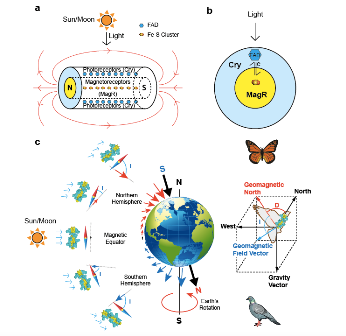Peking University, Nov. 16, 2015: Dr. XieCan at School of Life Sciences, Peking University and his collaborators discovered a novel magnetoreceptor protein (named MagR)and suggested a biocompass model for animal magnetoreception and navigation. A paper entitled “A magnetic protein biocompass”was online published on Nature Materials, 16 November 2015.
Animals rely on senses to perceive the surrounding physical world. The molecular detail of familiar senses such as vision, hearing, taste, smell and touch has been well characterized, and yet others remain a mystery. Magnetic sense is the ability to detect the Earth’s magnetic field, and use this information as navigational cues. The nature of this enigmatic sense has remained a fascinating and unresolved biological mystery.
By screening the genome of fruit flies on the basis of rational biological assumptions, Xie and colleagues identified a novel magnetoreceptor(named MagR) that couples with units of a light-sensitive cryptochrome protein (Cry) and spontaneously aligns in the direction of external magnetic fields. It is the first time that a biological compass is identified for an organism to sense the magnetic field.
Using biochemical and biophysical methods, they also show that the MagR/Cry complex is stable in the retina of pigeons and is evolutionarily conserved from insect to human, such as fruit flies, butterflies, pigeons, robins, rats, mole rats, sharks, turtles, and humans. The biocompass model proposed in this study may serve as a universalmachineryfor animalmagnetoreception and is openingafield for ultimately uncovering the mystery of animal navigation and homing.The protein’smagnetic properties could also lead to a broad range of magnetic-field-induced applicationsincludingmanipulation of macromolecules, modulation of biological processesand magnetogenetics.
Figure modified from Qin et al. Nature Materials, advance online publication, 16 November 2015 (DOI 10.1038/nature4484).
